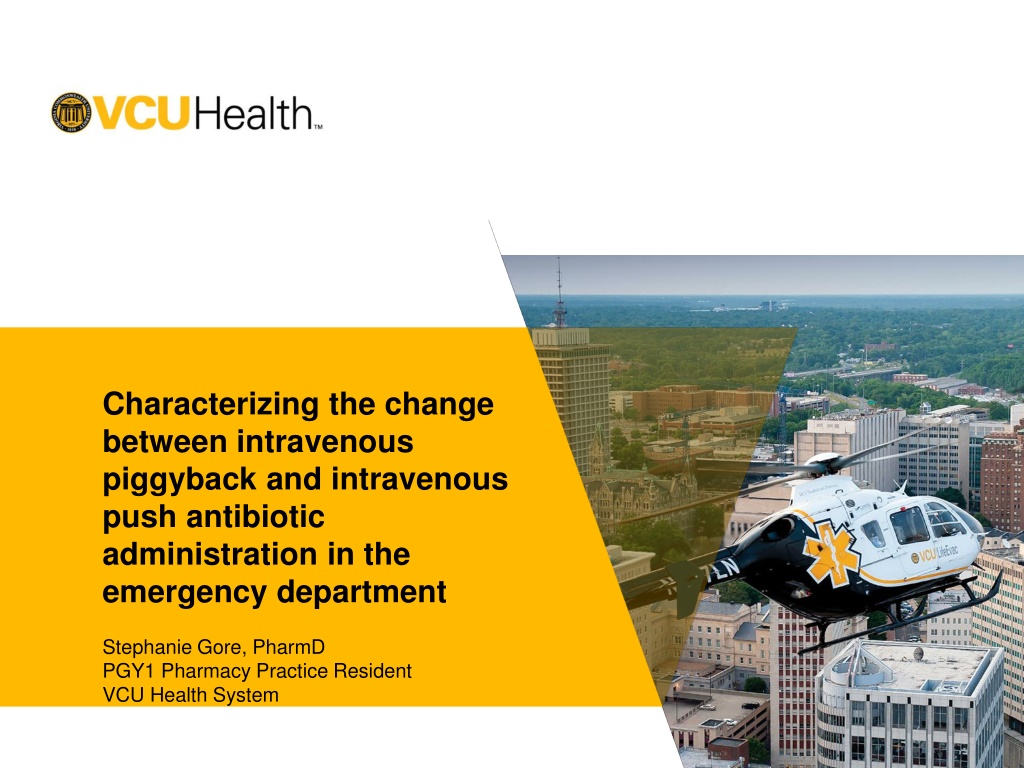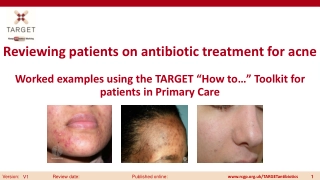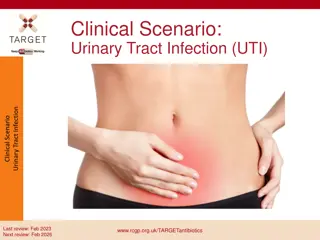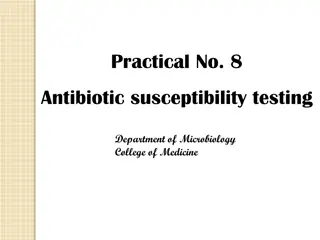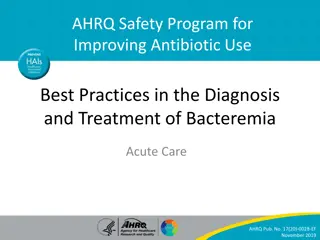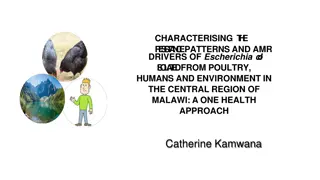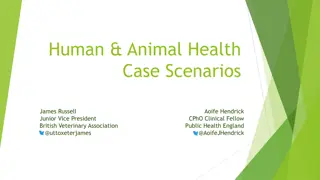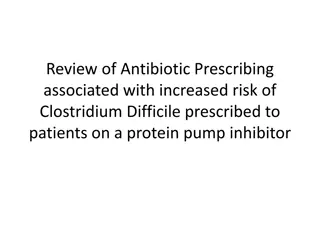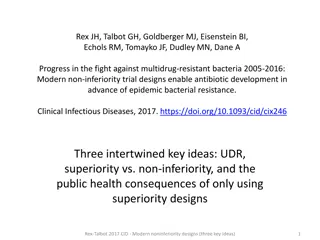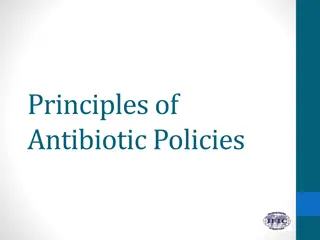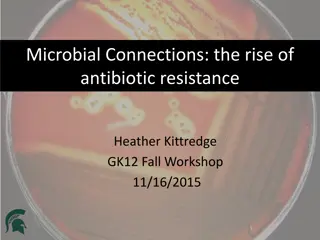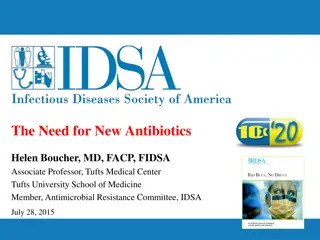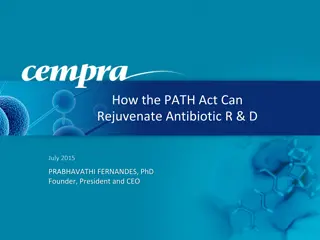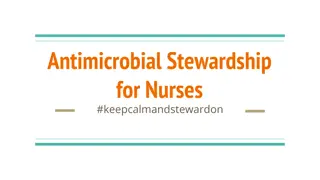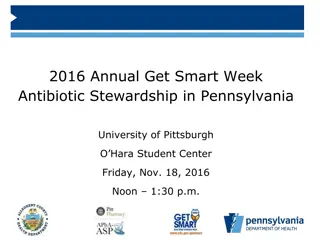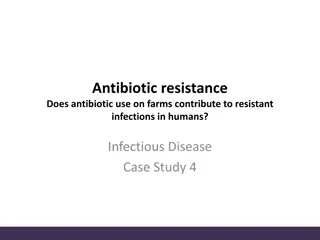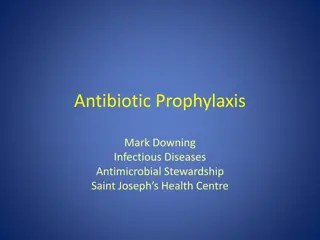Understanding Differences in IV Antibiotic Administration in Emergency Departments
Characterizing the shift from intravenous piggyback to intravenous push antibiotic administration in the emergency department, this study highlights the impact of antibiotic timing on patient outcomes, emphasizing the importance of quick and appropriate empiric antibiotic administration. Insights from current literature and a drug shortage scenario further elucidate the need for efficient IV antibiotic administration protocols to improve patient care.
Download Presentation

Please find below an Image/Link to download the presentation.
The content on the website is provided AS IS for your information and personal use only. It may not be sold, licensed, or shared on other websites without obtaining consent from the author. Download presentation by click this link. If you encounter any issues during the download, it is possible that the publisher has removed the file from their server.
E N D
Presentation Transcript
Characterizing the change between intravenous piggyback and intravenous push antibiotic administration in the emergency department Stephanie Gore, PharmD PGY1 Pharmacy Practice Resident VCU Health System
Disclosure The authors and contributors of this project have no conflicts of interest to disclose 2
Current Literature Study Design Outcome Kumar et al (2006) Retrospective cohort study of 14 intensive care units (ICU) and 10 hospitals Adjusted mortality odds ratio (OR) 1.119 per hour delay (95%CI 1.103-1.136, p<0.001) Gaieski et al (2010) Single center cohort study Significant association with time from triage to appropriate antibiotics of <60 minutes and mortality (19.5% vs. 33.2%; OR 0.30 [95% CI, 0.11 0.83]) Ferrer et al (2014) Retrospective analysis of 165 ICUs in Europe, United States, and South America Adjusted hospital mortality OR increased from 1 to 1.52 as time to antibiotic administration increased from 0 to >6 hours Kumar et al. 2006. Crit Care Med. 34 (6):1589-1596. Gaieski et al. 2010. Crit Care Med. 38 (4):1045-1053. Ferrer et al. 2014. Crit Care Med. 42 (8): 1749-1755. 3
Antibiotic Timing Current literature has associated quicker, appropriate empiric antibiotic administration with reduced mortality 2016 Surviving Sepsis Campaign guidelines recommend administration of antibiotics within one hour after recognition of sepsis (grade 1B) Kumar et al. 2006. Crit Care Med. 34 (6):1589-1596. Gaieski et al. 2010. Crit Care Med. 38 (4):1045-1053. Ferrer et al. 2014. Crit Care Med. 42 (8): 1749-1755. Rhodes A, et al. 2017.Crit Care Med.45(3):486-552 4
Drug Shortage September 2017 Hurricane Maria devastated Puerto Rico Pharmaceutical products made in Puerto Rico account for about 10% of all drugs consumed in United States November 2017 Critical antibiotic shortages force VCUHS to change from IVPB to IVP antibiotics Cefazolin Cefepime Ceftriaxone IVPB: intravenous piggyback IVP: intravenous push https://www.fda.gov/downloads/newsevents/n ewsroom/fdainbrief/ucm584030.pdf 5
Intravenous Piggyback vs Intravenous Push ED medication distribution IVP cefepime 2018 Administration: 3-5 mins IVPB cefepime 2017 Administration: 30-60 mins Materials: 10 mL syringe 18 gauge needle 10 mL NaCl 0.9% Materials: IV tubing Alaris pump Is there a difference between IVPB and IVP cefepime administration? IV: Intravenous ED: Emergency department Images retrieved from: http://products.fresenius-kabi.us/product-184.html https://www.bbraunusa.com/en/products/b0/2g-cefepime-for-injectionuspanddextroseinjectionusp.html https://www.allivet.com/p-2997-18g-x-1-inch-needle https://www.amazon.com/BD-302995-Box-Syringe-Only-Luer-Lok https://www.aaawholesalecompany.com/hos-488820-pk.html 6
Outcomes Primary Time from order to administration of first empiric antibiotic Time from order to administration of second empiric antibiotic (if applicable) Duration of treatment Mortality Direct cost differences Secondary Safety Newly documented adverse event 7
Methods Approved by VCU Institutional Review Board Retrospective, observational cohort study IVPB: January 2017 through June 2017 IVP: January 2018 through June 2018 Data collected from Cerner Information Systems Quality improvement project To help determine if the switch to IVP antibiotics should be continued once medication shortages resolve 8
Statistical Analysis IBM SPSS Statistics 25 Baseline characteristics: Descriptive statistics Continuous variables: Mann-Whitney U test Categorical variables: Chi-Square 9
Patient Population Age > 18 years old Received cefepime from January-June 2017 and January-June 2018 in the ED Inclusion Pregnancy Prisoners Did not receive cefepime in the ED Exclusion 10
Patient Flow Diagram Charts assessed for eligibility (n=499) Excluded: prisoners (n=17) Eligible patients (n=482) IVPB cefepime 2017 reviewed (n=165) IVP cefepime 2018 reviewed (n=317) Excluded: Excluded: not received in the ED (n=6) not received in the ED (n=13) IVPB cefepime 2017 included in analysis (N=159) IVP cefepime 2018 included in analysis (N=304) 11
Patient Demographics Baseline Characteristics IVPB (n=159) IVP (n=304) Age (mean, years, std. dev) 54.6 (+16.5) 54.4 (+ 15.2) Sex, no. (%) Male 82 (51.2) 138 (45.4) Race, no. (%) Caucasian African American Hispanic Asian 83 (51.9) 74 (46.3) 2 (1.3) 1 (0.6) 146 (48) 147 (48.4) 4 (1.3) 3 (1) Admitting unit, no. (%) General ICU Not admitted, ED Step-down 132 (82.5) 23 (14.4) 4 (2.5) 1 (0.6) 238 (78.3) 46 (15.1) 14 (4.6) 6 (2) Std dev: Standard deviation 12
Patient Demographics Baseline Characteristics IVPB (n=159) IVP (n=304) Type of infection, no. (%) Febrile neutropenia Pulmonary Bloodstream infection Unknown Genitourinary Cellulitis Osteomyelitis CNS Intraabdominal Cardiac Prophylaxis 38 (23.8) 31 (19.4) 28 (17.5) 25 (15.6) 16 (10) 10 (6.3) 4 (2.5) 4 (2.5) 3 (1.9) 1 (0.6) 0 (0) 34 (11.2) 48 (15.8) 63 (20.7) 81 (26.6) 29 (9.5) 31 (10.2) 5 (1.6) 4 (1.3) 7 (2.3) 1 (0.3) 1 (0.3) Initial antibiotic, no. (%) Cefepime Other 133 (83.1) 27 (16.9) 285 (93.8) 19 (6.3) 13
Primary and Secondary Outcomes Primary/Secondary Outcomes IVPB (n=159) IVP (n=304) P-value 58 (28-108.3) 42.5 (23-67.5) <0.001 Time from order to first antibiotic administration (mins, median, IQR range) 74 (47.5-112) 61 (33-91) 0.006 Time from order to second antibiotic administration (mins, median, IQR range) Duration of antibiotic treatment (days, median) 3 3 0.954 0.758 Reason for cefepime treatment discontinuation, no. (%) De-escalation/narrowing Broadening coverage Completion of treatment Therapy not indicated Other 75 (46.9) 15 (24) 12.5 (20) 28 (17.5) 8.1 (13) 154 (50.7) 35 (11.5) 43 (14.1) 52 (17.1) 20 (6.6) Mortality (during admission) no. (%) 11 (6.9) 23 (7.6) 0.933 1 (0.6) 6 (2) 0.464 New documented adverse event to cefepime, no. (%) Mins: Minutes IQR: Interquartile range 14
Characteristics of Adverse Events Adverse Events Throat swelling Itching Hives Flushing/hives Tongue swelling Unknown Total no. (%) IVPB (n=159) 1 IVP (n=304) 1 2 1 1 1 1 (0.6%) 6 (2%) 15
Direct Cost Savings IVPB IVP Characteristic Doses 159 304 Medication wholesale acquisition (WAC) 1 g = $11.72/Piggyback 2 g = $17.69/Piggyback 1 g = $5.83/vial 2 g = $9.34/vial Material cost $9.50/primary set $0.10/needle $0.18/syringe $0.35/NaCl 0.9% vial 1 g =$6.46 2 g =$9.97 Total cost per dose 1 g = $21.22 2 g = $27.19 Estimated cost savings per dose 1 g =$14.76 2 g =$17.22 * Includes price for primary set infusion tubing **Includes price for 10mL syringe, 18G needle, 10 mL NaCl 0.9% vial NaCl = Sodium chloride Pricing retrieved from: https://www.meadowsmedical.com/online-store/iv-pharmacy/iv-tubing/alaris-71-72-series-primary-set-detail http://shop.gohcl.com/default.aspx?page=item%20detail&itemcode=19837 16
Limitations Retrospective study Single institution Limited time period Documentation bias Restriction of meropenem 17
Conclusion The utilization of IVP antibiotics resulted in faster treatment times compared to IVPB antibiotics with median time savings of 16 minutes Duration of antibiotic therapy, reason for cefepime treatment discontinuation, and mortality were not significantly different between the two groups Adverse events were slightly higher in the IVP group, but not statistically significant There was direct cost savings with IVP compared to IVPB IVPB: intravenous piggyback IVP: intravenous push 18
Future Directions Recommend to pharmacy leadership to continue the use of IVP antibiotics even after the drug shortage resolves due to time savings and cost savings Examine the utilization of other IVP antibiotics beyond cefepime Nursing time and satisfaction survey 19
Acknowledgements Tammy Nguyen, PharmD, BCPS Stephen Miller, DO 20
Characterizing the change between intravenous piggyback and intravenous push antibiotic administration in the emergency department Stephanie Gore, PharmD PGY1 Pharmacy Practice Resident VCU Health System
